Integrating Consumption-Based Metrics into Sectoral Carbon Budgets to Enhance Sustainability Monitoring of Building Activities
Abstract
1. Introduction
1.1. GHGE Accounting Systems
1.2. Buildings in the Needs–Activities–Sectors Framework
1.3. The Need for Embodied GHGE Budget
1.4. Contributions of the Paper
- At the national level, how do we account for the life-cycle emissions of buildings as a cross-sectoral and cross-border activity?
- How do we apply suitable decarbonization pathways to the different scopes of emissions identified, in particular embodied GHGEs, to complement the coverage of the existing sectoral budgets?
2. Materials and Methods
2.1. System Boundary
2.2. GHGE Accounting Methods
2.2.1. Operational GHGE Calculation
2.2.2. Embodied GHGE Calculation at National Level
- A 3 regions × 8 sectors classification. It enables to couple the results with the SECTEN format used by the SNBC. An additional services sector and the intra-sectoral exchanges of the construction sector replace the residential and tertiary. France, the European Union, and an aggregated Rest of the World (RoW) are represented in terms of geographical regions.
- A 15 regions × 19 sectors classification. It is inspired from the traditional aggregation in 17 sectors in IO tables, with additional custom sectors for which the IEA scenarios provide detailed pathways by 2050.
2.3. Scenarios and WLC Budgets
- Net-Zero Emissions Scenario: it reaches a state of net-zero emissions in 2050 globally. It is compatible with a 1.5 °C temperature rise in 2100 with limited overshoot.
- Announced Pledges Scenario (APS): it assumes that the policies and targets announced by countries will be implemented fully and on time, including their long-term Nationally Determined Contributions (NDC) pledges. It is associated with a 1.7 °C temperature rise in 2100.
- Stated Policies Scenario (STEPS): it considers a wide range of policies and measures those that are currently in place or under development in different countries. It is associated with a 2.4 °C temperature rise in 2100.
3. Results
3.1. GHGE Accounting
3.1.1. Operational GHGEs
3.1.2. Embodied GHG Emissions
3.1.3. Whole-Life GHGEs
3.2. Scenarios and WLC Budgets
3.2.1. Operation GHGE Budgets
3.2.2. Embodied GHGE Budgets
3.2.3. WLC Emissions Budgets
4. Discussion
5. Conclusions
Author Contributions
Funding
Institutional Review Board Statement
Informed Consent Statement
Data Availability Statement
Conflicts of Interest
Abbreviations
| APS | Announced Pledges Scenario |
| CBA | Consumption-Based Accounting |
| EF | Emission Factor |
| GHGEs | Greenhouse Gas Emissions |
| IOA | Input–Output Analysis |
| IPCC | Intergovernmental Panel on Climate Change |
| LCA | Life-cycle Assessment |
| NZS | Net-Zero Emissions Scenario |
| MRIO | Multi-Regional Input–Output |
| PBA | Production-Based Accounting |
| SNBC | Low-Carbon National Strategy |
| STEPS | Stated Policies Scenario |
| WLC | Whole-Life Carbon |
Appendix A. Operational GHGEs
Appendix A.1. French SECTEN Format
- Heating, domestic hot water, and cooking;
- Air conditioning;
- Refrigeration;
- Use of products (e.g., paints and aerosols);
- Domestic machinery (e.g., gardening);
- Burning and sewage;
- Other domestic activities.
- Heating, domestic hot water, and cooking;
- Air conditioning;
- Refrigeration;
- Use of products (e.g., paints and aerosols);
- Other tertiary activities.
Appendix A.2. Emission Factor of Electricity
| D-EF | LC-EF | |
|---|---|---|
| Average | 0.0418 | 0.0607 |
| Heating | 0.0524 | 0.0717 |
| Hot water | 0.0414 | 0.0595 |
| Lighting | 0.0447 | 0.0631 |
| Air conditioning | 0.0407 | 0.041 |
| Other usages | 0.0414 | 0.0587 |
Appendix B. Concordance Matrices
| IEA Pathways | Sectors |
|---|---|
| Oil | Petroleum products |
| Natural gas | Gas |
| Final consumption | Agriculture, hunting, forestry and fishing Electrical and machinery |
| Industry | Construction Manufacturing and recycling Metal and metal products Mining and quarrying Other non-metallic products Others |
| Iron and Steel | Iron and Steel |
| Cement | Cement |
| Transport (road) | Transport |
| Services | Public administration Financial intermediation and business activity |
Appendix C. Cement and Concrete Value Chain Decarbonization Lever
References
- Masson Delmotte, V.; Zhai, P.; Pirani, A.; Connors, S.L.; Péan, C.; Berger, S.; Caud, N.; Chen, Y.; Goldfarb, L.; Gomis, M.I.; et al. Summary for Policymakers; Intergovernmental Panel on Climate Change (IPCC): Geneva, Switzerland, 2021. [Google Scholar] [CrossRef]
- Dhakal, S.; Minx, J.C.; Toth, F.L.; Abdel-Aziz, A.; Figueroa Meza, M.J.; Hubacek, K.; Jonckheere, I.G.C.; Kim, Y.; Nemet, G.F.; Pachauri, S.; et al. Emissions Trends and Drivers; Intergovernmental Panel on Climate Change (IPCC): Geneva, Switzerland, 2022. [Google Scholar] [CrossRef]
- United Nations. Paris Agreement. 2015. Available online: https://unfccc.int/sites/default/files/resource/parisagreement_publication.pdf (accessed on 11 June 2024).
- UNFCCC. United Nations Framework Convention on Climate Change. 1992. Available online: https://unfccc.int/resource/docs/convkp/conveng.pdf (accessed on 11 June 2024).
- UNFCCC. Kyoto Protocol to the United Nations Framework Convention on Climate Change; UNFCCC: Bonn, Germany, 1998. [Google Scholar] [CrossRef]
- IPCC. Overview. 2006. Available online: http://www.ipcc-nggip.iges.or.jp/public/2006gl/index.html (accessed on 11 June 2024).
- Steininger, K.W.; Lininger, C.; Meyer, L.H.; Muñoz, P.; Schinko, T. Multiple Carbon Accounting to Support Just and Effective Climate Policies; Nature Publishing Group: Berlin, Germany, 2015. [Google Scholar] [CrossRef]
- Hertwich, E.G.; Wood, R. The growing importance of scope 3 greenhouse gas emissions from industry. Environ. Res. Lett. 2018, 13, 104013. [Google Scholar] [CrossRef]
- Cabernard, L.; Pfister, S.; Hellweg, S. A new method for analyzing sustainability performance of global supply chains and its application to material resources. Sci. Total Environ. 2019, 684, 164–177. [Google Scholar] [CrossRef] [PubMed]
- Steininger, K.W.; Munoz, P.; Karstensen, J.; Peters, G.P.; Strohmaier, R.; Velázquez, E. Austria’s consumption-based greenhouse gas emissions: Identifying sectoral sources and destinations. Glob. Environ. Chang. 2018, 48, 226–242. [Google Scholar] [CrossRef]
- CITEPA. Rapport SECTEN 2022: Gaz à effet de Serre et Polluants Atmosphériques Bilan des émissions en France de 1990 à 2021. 2022. Available online: https://www.citepa.org/fr/secten/ (accessed on 11 June 2024).
- UNEP. 2022 Global Status Report for Buildings and Construction: Towards a Zero-Emission, Efficient and Resilient Buildings and Construction Sector. 2022. Available online: https://www.unep.org/resources/publication/2022-global-status-report-buildings-and-construction (accessed on 11 June 2024).
- Ministère de la Transition Ecologique. Décret n° 2021-1004 du 29 Juillet 2021 Relatif aux Exigences de Performance énergétique et Environnementale des Constructions de Bâtiments en France Métropolitaine. 2021. Available online: https://www.legifrance.gouv.fr/jorf/id/JORFTEXT000043877196 (accessed on 11 June 2024).
- Habert, G.; Röck, M.; Steininger, K.; Lupísek, A.; Birgisdottir, H.; Desing, H.; Chandrakumar, C.; Pittau, F.; Passer, A.; Rovers, R.; et al. Carbon budgets for buildings: Harmonising temporal, spatial and sectoral dimensions. Build. Cities 2020, 1, 429–452. [Google Scholar] [CrossRef]
- Lützkendorf, T. Transition to a Cross-Sectoral Approach for Decarbonising the Built Environment—Commentaries. 2021. Available online: https://www.buildingsandcities.org/insights/commentaries/cop26-cross-sectoral.html (accessed on 11 June 2024).
- Onat, N.C.; Kucukvar, M. Carbon footprint of construction industry: A global review and supply chain analysis. Renew. Sustain. Energy Rev. 2020, 124, 109783. [Google Scholar] [CrossRef]
- Huang, L.; Krigsvoll, G.; Johansen, F.; Liu, Y.; Zhang, X. Carbon emission of global construction sector. Renew. Sustain. Energy Rev. 2018, 81, 1906–1916. [Google Scholar] [CrossRef]
- Crawford, R.H. Greenhouse Gas Emissions of Global Construction Industries Greenhouse Gas Emissions of Global Construction Industries. IOP Conf. Ser. Mater. Sci. Eng. 2022, 1218. [Google Scholar] [CrossRef]
- Acquaye, A.A.; Duffy, A.P. Input-output analysis of Irish construction sector greenhouse gas emissions. Build. Environ. 2010, 45, 784–791. [Google Scholar] [CrossRef]
- O’Hegarty, R.; Wall, S.; Kinnane, O. Whole life carbon quantification of the built environment: Case study Ireland. Build. Environ. 2022, 226, 109730. [Google Scholar] [CrossRef]
- Yu, M.; Wiedmann, T.; Crawford, R.; Tait, C. The Carbon Footprint of Australia’s Construction Sector. Procedia Eng. 2017, 180, 211–220. [Google Scholar] [CrossRef]
- Frischknecht, R.; Alig, M.; Nathani, C.; Hellmüller, P.; Stolz, P. Carbon footprints and reduction requirements: The Swiss real estate sector. Build. Cities 2020, 1, 325–336. [Google Scholar] [CrossRef]
- Pomponi, F.; Stephan, A. Water, energy, and carbon dioxide footprints of the construction sector: A case study on developed and developing economies. Water Res. 2021, 194, 116935. [Google Scholar] [CrossRef] [PubMed]
- Eurostat. Manual of Supply, Use and Input-Output Tables. 2008. Available online: https://ec.europa.eu/eurostat/web/products-manuals-and-guidelines/-/ks-ra-07-013 (accessed on 11 June 2024).
- Minx, J.C.; Wiedmann, T.; Wood, R.; Peters, G.P.; Lenzen, M.; Owen, A.; Scott, K.; Barrett, J.; Hubacek, K.; Baiocchi, G.; et al. Input-output analysis and carbon footprinting: An overview of applications. Econ. Syst. Res. 2009, 21, 187–216. [Google Scholar] [CrossRef]
- Wiedmann, T.O.; Chen, G.; Barrett, J. The Concept of City Carbon Maps: A Case Study of Melbourne, Australia. J. Ind. Ecol. 2016, 20, 676–691. [Google Scholar] [CrossRef]
- Baynes, T.M.; Wiedmann, T. General approaches for assessing urban environmental sustainability. Curr. Opin. Environ. Sustain. 2012, 4, 458–464. [Google Scholar] [CrossRef]
- Steininger, K.W.; Meyer, L.; Nabernegg, S.; Kirchengast, G. Sectoral carbon budgets as an evaluation framework for the built environment. Build. Cities 2020, 1, 337–360. [Google Scholar] [CrossRef]
- Röck, M.; Saade, M.R.M.; Balouktsi, M.; Rasmussen, F.N.; Birgisdottir, H.; Frischknecht, R.; Habert, G.; Lützkendorf, T.; Passer, A. Embodied GHG emissions of buildings—The hidden challenge for effective climate change mitigation. Appl. Energy 2020, 258, 114107. [Google Scholar] [CrossRef]
- UNEP. Building Materials and the Climate: Constructing a New Future. 2023. Available online: https://wedocs.unep.org/xmlui/handle/20.500.11822/43293 (accessed on 11 June 2024).
- Röck, M.; Sørensen, A.; Steinmann, J.; Horup, L.H.; Tozan, B.; Den, X.L. Towards Embodied Carbon Benchmarks for Buildings in Europe. 2022. Available online: https://fs.hubspotusercontent00.net/hubfs/7520151/RMC/Content/EU-ECB-5-all-in-one-report.pdf (accessed on 11 June 2024).
- Priore, Y.D.; Habert, G.; Jusselme, T. Exploring the gap between carbon-budget-compatible buildings and existing solutions—A Swiss case study. Energy Build. 2023, 278, 112598. [Google Scholar] [CrossRef]
- Horup, L.H.; Birgisdóttir, H.; Ryberg, M.W. Defining dynamic science-based climate change budgets for countries and absolute sustainable building targets. Build. Environ. 2023, 230, 109936. [Google Scholar] [CrossRef]
- Pálenský, D.; Lupíšek, A. Carbon Benchmark for Czech Residential buildings based on climate goals set by the Paris Agreement for 2030. Sustainability 2019, 11, 6085. [Google Scholar] [CrossRef]
- Wood, R.; Moran, D.; Stadler, K.; Ivanova, D.; Steen-Olsen, K.; Tisserant, A.; Hertwich, E.G. Prioritizing Consumption-Based Carbon Policy Based on the Evaluation of Mitigation Potential Using Input-Output Methods. J. Ind. Ecol. 2018, 22, 540–552. [Google Scholar] [CrossRef]
- Legifrance. LOI n°2015-992 du 17 août 2015 Relative à la Transition énergétique pour la Croissance Verte (1)—Légifrance. 2015. Available online: https://www.legifrance.gouv.fr/loda/id/JORFTEXT000031044385/ (accessed on 11 June 2024).
- Ramboll; BPIE; KU Leven. Supporting the Development of a Roadmap for the Reduction of Whole Life Carbon of Buildings. 2023. Available online: https://7520151.fs1.hubspotusercontent-na1.net/hubfs/7520151/RMC/Content/Ramboll%2c%20BPIE%2c%20KU%20Leuven_Technical%20Report_July%202023.pdf (accessed on 11 June 2024).
- Stadler, K.; Wood, R.; Bulavskaya, T.; Södersten, C.J.; Simas, M.; Schmidt, S.; Usubiaga, A.; Acosta-Fernández, J.; Kuenen, J.; Bruckner, M.; et al. EXIOBASE 3: Developing a Time Series of Detailed Environmentally Extended Multi-Regional Input-Output Tables. J. Ind. Ecol. 2018, 22, 502–515. [Google Scholar] [CrossRef]
- Suh, S.; Huppes, G. Methods for life cycle inventory of a product. J. Clean. Prod. 2005, 13, 687–697. [Google Scholar] [CrossRef]
- AFNOR. Norme NF EN 15978. 2012. Available online: https://www.boutique.afnor.org/fr-fr/norme/nf-en-15978/contribution-des-ouvrages-de-construction-au-developpement-durable-evaluati/fa160273/39288 (accessed on 11 June 2024).
- Lützkendorf, T.; Frischknecht, R. (Net-) zero-emission buildings: A typology of terms and definitions. Build. Cities 2020, 1, 662–675. [Google Scholar] [CrossRef]
- WBCSD; WRI. The GHG Protocol: A Corporate Accounting and Reporting Standard. Greenh. Gas Protoc. 2012. Available online: https://ghgprotocol.org/corporate-standardhttps://ghgprotocol.org/corporate-standard (accessed on 11 June 2024).
- Onat, N.C.; Kucukvar, M.; Tatari, O. Scope-based carbon footprint analysis of U.S. residential and commercial buildings: An input-output hybrid life cycle assessment approach. Build. Environ. 2014, 72, 53–62. [Google Scholar] [CrossRef]
- CITEPA. Rapport OMINEA 2022. 2022. Available online: https://www.citepa.org/fr/ominea/ (accessed on 11 June 2024).
- SDES. Chiffres clés de l’énergie. 2021. Available online: https://www.statistiques.developpement-durable.gouv.fr/chiffres-cles-de-lenergie-edition-2021 (accessed on 11 June 2024).
- RTE. Chapitre 3: La Consommation. 2022. Available online: https://assets.rte-france.com/prod/public/2022-06/FE2050%20_Rapport%20complet_3.pdf (accessed on 11 June 2024).
- ADEME. Documentation Base Carbone®—Fe par Usage de L’Electricite. 2020. Available online: https://base-empreinte.ademe.fr/ (accessed on 11 June 2024).
- SDES. Les Facteurs d’évolution des émissions de CO2 liées à l’énergie en France de 1990 à 2020. 2022. Available online: https://www.statistiques.developpement-durable.gouv.fr/sites/default/files/2022-09/datalab_106_les_facteurs_d%E2%80%99evolution_des_emissions_de_co2_liees_a_l_energie_en_france_de_1990_a_2020_septembre2022.pdf (accessed on 11 June 2024).
- Heeren, N.; Fishman, T. A database seed for a community-driven material intensity research platform. Sci. Data 2019, 6, 1–10. [Google Scholar] [CrossRef] [PubMed]
- Leontief, W. Quantitative Input and Output Relations in the Economic Systems of the United States. Rev. Econ. Stat. 1936. [Google Scholar] [CrossRef]
- Leontief, W. Environmental Repercussions and the Economic Structure: An Input-Output Approach. Rev. Econ. Stat. 1970, 52, 262–271. [Google Scholar] [CrossRef]
- de Koning, A.; Eisenmenger, N.; van der Voet, E. Topical Paper 1: Resource-Efficiency in the Built Environment—A Broad-Brushed, Top-Down Assessment of Priorities Scenarios and Options towards a Resource. 2013. Available online: https://ec.europa.eu/environment/enveco/resource_efficiency/topical.htm (accessed on 11 June 2024).
- Wood, R.; Stadler, K.; Bulavskaya, T.; Lutter, S.; Giljum, S.; de Koning, A.; Kuenen, J.; Schütz, H.; Acosta-Fernández, J.; Usubiaga, A.; et al. Global sustainability accounting-developing EXIOBASE for multi-regional footprint analysis. Sustainability 2015, 7, 138–163. [Google Scholar] [CrossRef]
- Wiedmann, T. On the decomposition of total impact multipliers in a supply and use framework. J. Econ. Struct. 2017, 6, 1–11. [Google Scholar] [CrossRef]
- Fishman, T.; Heeren, N.; Pauliuk, S.; Berrill, P.; Tu, Q.; Wolfram, P.; Hertwich, E.G. A comprehensive set of global scenarios of housing, mobility, and material efficiency for material cycles and energy systems modeling. J. Ind. Ecol. 2021, 25, 305–320. [Google Scholar] [CrossRef]
- Börjeson, L.; Höjer, M.; Dreborg, K.H.; Ekvall, T.; Finnveden, G. Scenario types and techniques: Towards a user’s guide. Futures 2006, 38, 723–739. [Google Scholar] [CrossRef]
- IEA. World Energy Outlook 2023. 2023. Available online: https://www.iea.org/reports/world-energy-outlook-2023 (accessed on 11 June 2024).
- Huppmann, D.; Gidden, M.J.; Nicholls, Z.; Hörsh, J.; Lamboll, R. pyam: Analysis and visualisation of integrated assessment and macro-energy scenarios. Open Res. Eur. 2021. [Google Scholar] [CrossRef]
- C40; ARUP; University of Leeds. Building and Infrastructure Consumption Emissions. 2019. Available online: https://www.arup.com/perspectives/publications/research/section/the-future-of-urban-consumption-in-a-1-5c-world (accessed on 11 June 2024).
- Davis, S.J.; Lewis, N.S.; Shaner, M.; Aggarwal, S.; Arent, D.; Azevedo, I.L.; Benson, S.M.; Bradley, T.; Brouwer, J.; Chiang, Y.M.; et al. Net-zero emissions energy systems. Science 2018, 360, eaas9793. [Google Scholar] [CrossRef] [PubMed]
- Schulte, S.; Jakobs, A.; Pauliuk, S. Estimating the uncertainty of the greenhouse gas emission accounts in global multi-regional input–output analysis. Earth Syst. Sci. Data 2024, 16, 2669–2700. [Google Scholar] [CrossRef]
- Crawford, R.H.; Bontinck, P.A.; Stephan, A.; Wiedmann, T.; Yu, M. Hybrid life cycle inventory methods—A review. J. Clean. Prod. 2018, 172, 1273–1288. [Google Scholar] [CrossRef]
- Horup, L.H.; Steinmann, J.; Le Den, X.; Röck, M.; Sørensen, A.; Tozan, B.; Birgisdottir, H. Towards Embodied Carbon Benchmarks for Buildings in Europe—#3 Defining Budget-Based Targets: A Top-Down Approach; Zenodo: Geneve, Switzerland, 2022. [Google Scholar] [CrossRef]
- Heijungs, R.; De Koning, A.; Guinée, J.B. Maximizing affluence within the planetary boundaries. Int. J. Life Cycle Assess. 2014, 19, 1331–1335. [Google Scholar] [CrossRef]
- de Oliveira Fernandes, M.A.; Keijzer, E.; van Leeuwen, S.; Kuindersma, P.; Melo, L.; Hinkema, M.; Gonçalves Gutierrez, K. Material-versus energy-related impacts: Analysing environmental trade-offs in building retrofit scenarios in the Netherlands. Energy Build. 2021, 231, 110650. [Google Scholar] [CrossRef]
- Verhagen, T.J.; Cetinay, H.I.; Van Der Voet, E.; Sprecher, B. Transitioning to Low-Carbon Residential Heating: The Impacts of Material-Related Emissions. Environ. Sci. Technol. 2021, 56, 8561–8570. [Google Scholar] [CrossRef] [PubMed]
- Cabeza, L.F.; Bai, Q.; Bertoldi, P.; Kihila, J.M.; Lucena, A.F.P.; Mata, É.; Mirasgedis, S.; Novikova, A.; Saheb, Y. Buildings; Intergovernmental Panel on Climate Change (IPCC): Geneva, Switzerland, 2022. [Google Scholar] [CrossRef]
- Habert, G.; Miller, S.; John, V.; Provis, J.; Favier, A.; Horvath, A.; Scrivener, K. Environmental impacts and decarbonization strategies in the cement and concrete industries. Nat. Rev. Earth Environ. 2020, 1, 559–573. [Google Scholar] [CrossRef]
- Morfeldt, J.; Larsson, J.; Andersson, D.; Johansson, D.J.A.; Rootzén, J.; Hult, C.; Karlsson, I. Emission pathways and mitigation options for achieving consumption-based climate targets in Sweden. Commun. Earth Environ. 2023, 4, 1–14. [Google Scholar] [CrossRef]
- De Koning, A.; Huppes, G.; Deetman, S.; Tukker, A. Scenarios for a 2 °C world: A trade-linked input–output model with high sector detail. Clim. Policy 2016, 16, 301–317. [Google Scholar] [CrossRef]
- Wiebe, K.S.; Bjelle, E.L.; Többen, J.; Wood, R. Implementing exogenous scenarios in a global MRIO model for the estimation of future environmental footprints. J. Econ. Struct. 2018, 7, 20. [Google Scholar] [CrossRef]
- Donati, F.; Aguilar-Hernandez, G.A.; Sigüenza-Sánchez, C.P.; de Koning, A.; Rodrigues, J.F.; Tukker, A. Modeling the circular economy in environmentally extended input-output tables: Methods, software and case study. Resour. Conserv. Recycl. 2020, 152, 104508. [Google Scholar] [CrossRef]
- Gibon, T.; Wood, R.; Arvesen, A.; Bergesen, J.D.; Suh, S.; Hertwich, E.G. A Methodology for Integrated, Multiregional Life Cycle Assessment Scenarios under Large-Scale Technological Change. Environ. Sci. Technol. 2015, 49, 11218–11226. [Google Scholar] [CrossRef]
- Hertwich, E.G.; Gibon, T.; Bouman, E.A.; Arvesen, A.; Suh, S.; Heath, G.A.; Bergesen, J.D.; Ramirez, A.; Vega, M.I.; Shi, L. Integrated life-cycle assessment of electricity-supply scenarios confirms global environmental benefit of low-carbon technologies. Proc. Natl. Acad. Sci. USA 2015, 112, 6277–6282. [Google Scholar] [CrossRef] [PubMed]
- Lenzen, M. Errors in conventional and input-output-based life-cycle inventories. J. Ind. Ecol. 2000, 4, 127–148. [Google Scholar] [CrossRef]
- Teh, S.H.; Wiedmann, T.; Moore, S. Mixed-unit hybrid life cycle assessment applied to the recycling of construction materials. J. Econ. Struct. 2018, 7, 13. [Google Scholar] [CrossRef]
- Mastrucci, A.; Marvuglia, A.; Leopold, U.; Benetto, E. Life Cycle Assessment of building stocks from urban to transnational scales: A review. Renew. Sustain. Energy Rev. 2017, 74, 316–332. [Google Scholar] [CrossRef]
- Hollberg, A.; Lützkendorf, T.; Habert, G. Top-down or bottom-up?—How environmental benchmarks can support the design process. Build. Environ. 2019, 153, 148–157. [Google Scholar] [CrossRef]
- IEA. Net Zero by 2050 A Roadmap for the Global Energy Sector. 2021. Available online: https://www.iea.org/reports/net-zero-by-2050 (accessed on 11 June 2024).
- Miller, S.A.; Habert, G.; Myers, R.J.; Harvey, J.T. Perspective Achieving net zero greenhouse gas emissions in the cement industry via value chain mitigation strategies. One Earth 2021, 4, 1398–1411. [Google Scholar] [CrossRef]
- Pamenter, S.; Myers, R.J. Decarbonizing the cementitious materials cycle: A whole-systems review of measures to decarbonize the cement supply chain in the UK and European contexts. J. Ind. Ecol. 2021, 2012, 1–18. [Google Scholar] [CrossRef]
- Favier, A.; De Wolf, C.; Scrivener, K.; Habert, G. A Sustainable Future for the European Cement and Concrete Industry; ETH Zurich: Zurich, Switzerland, 2018. [Google Scholar] [CrossRef]
- ADEME. Plan de Transition Sectoriel de l’Industrie Cimentière en France: Rapport Final. 2021. Available online: https://librairie.ademe.fr/changement-climatique-et-energie/5041-plan-de-transition-sectoriel-de-l-industrie-cimentiere-en-france.html (accessed on 11 June 2024).
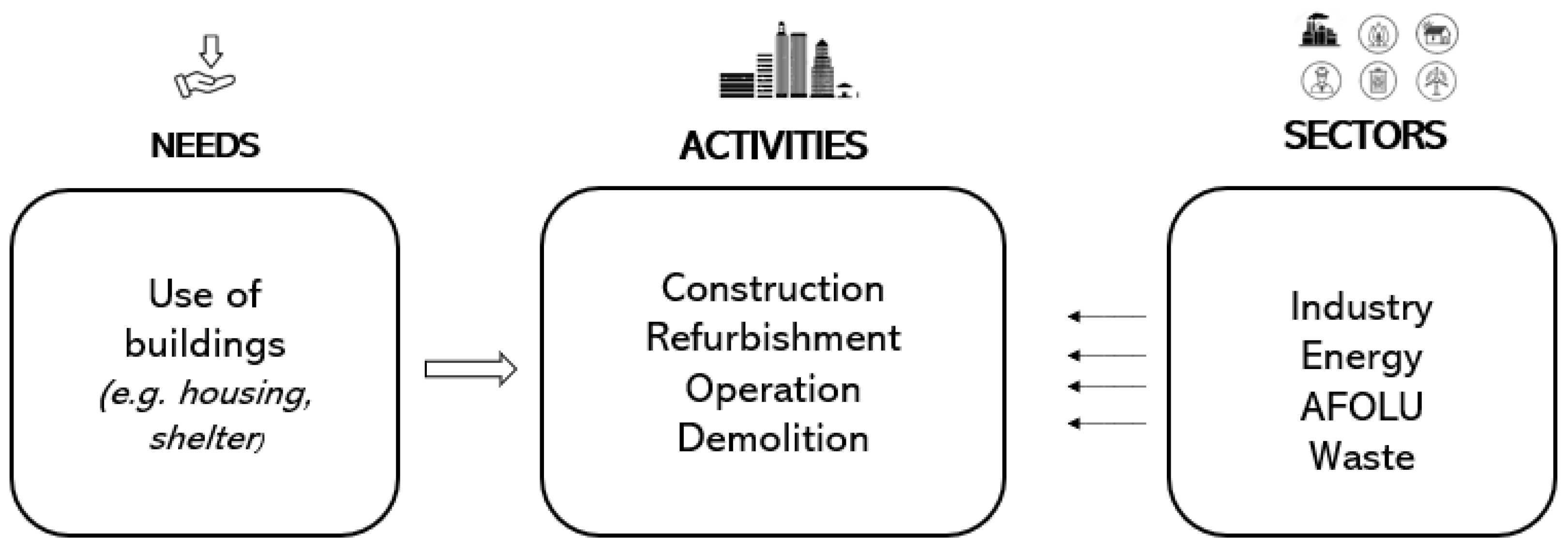
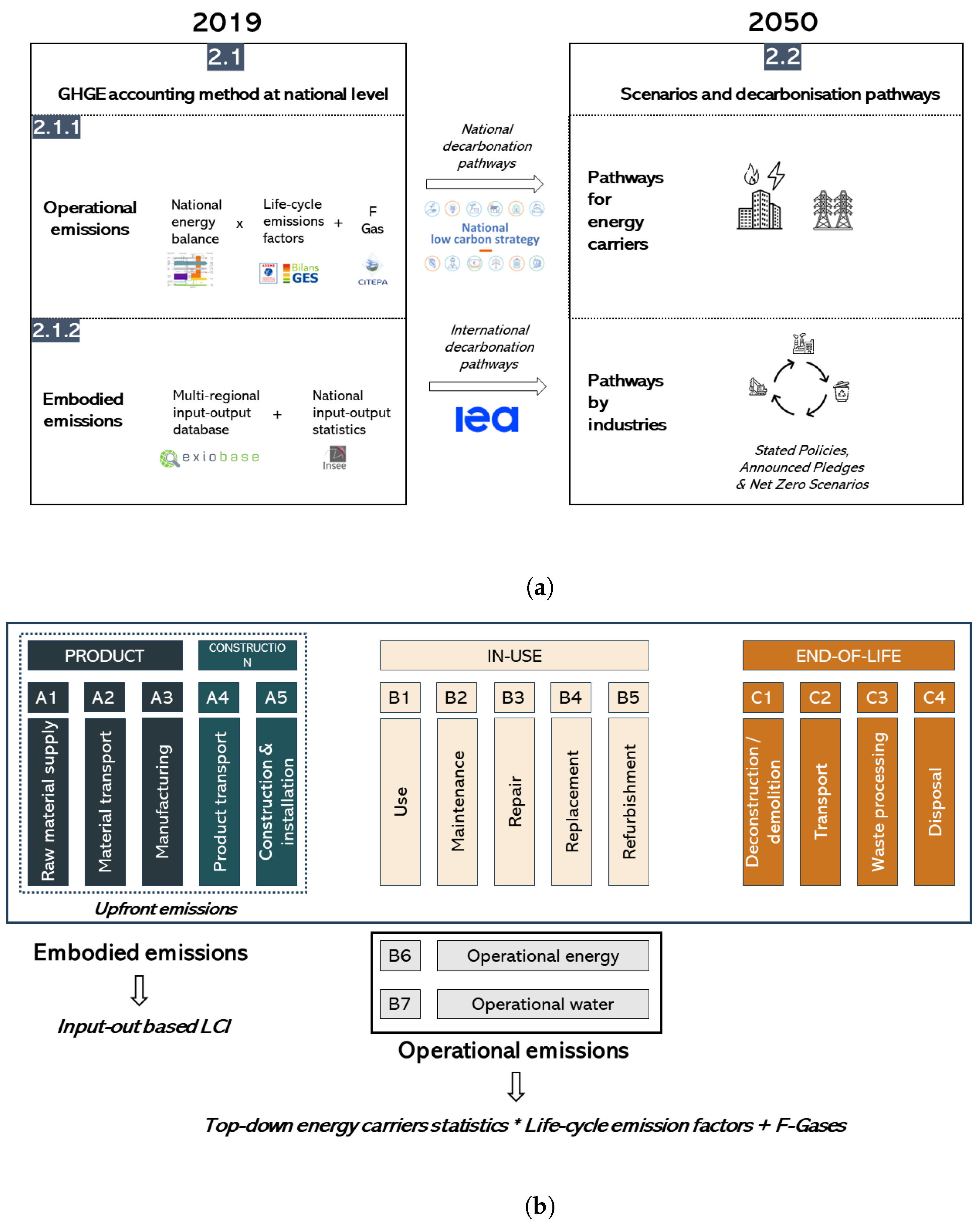
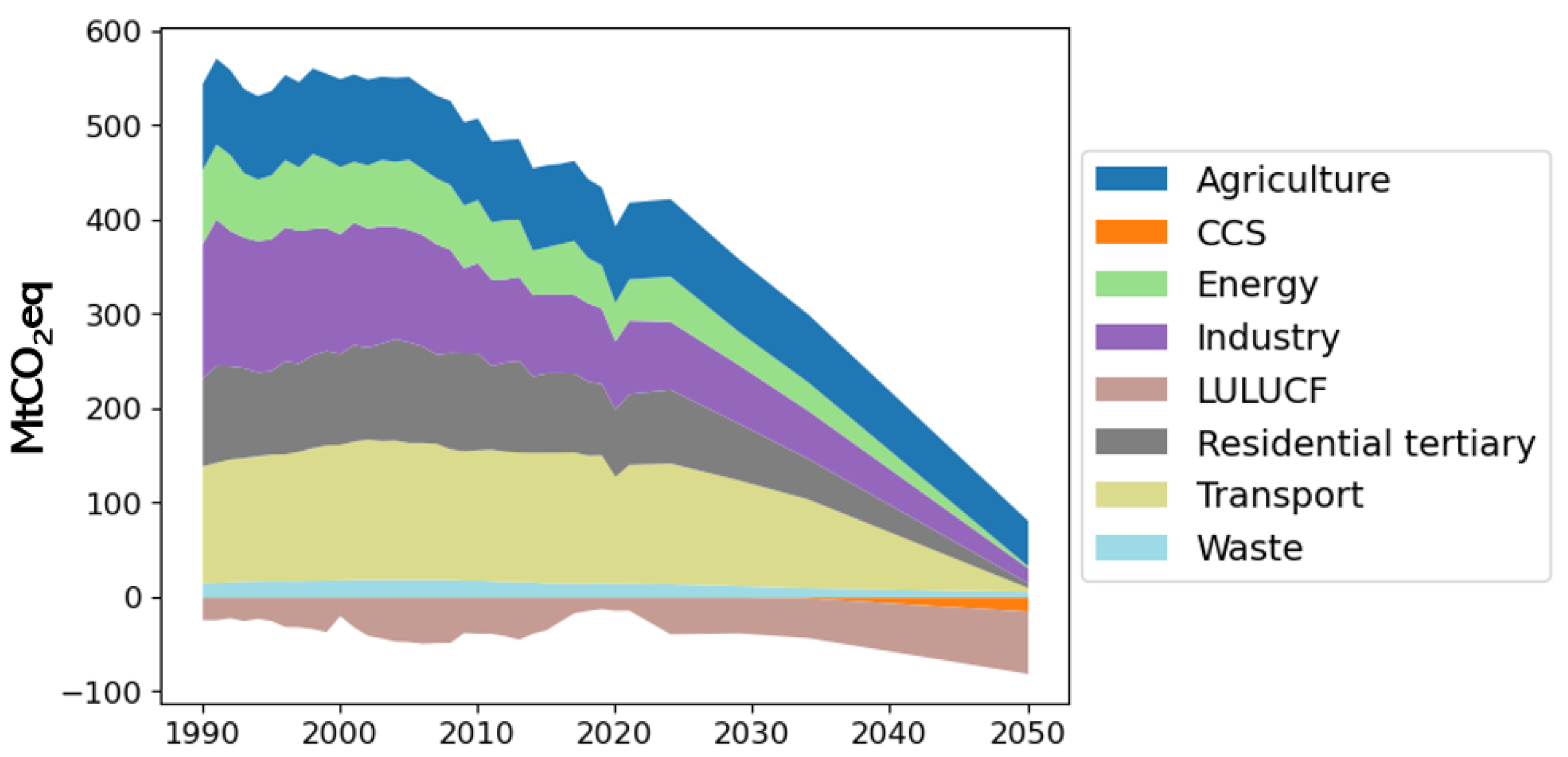
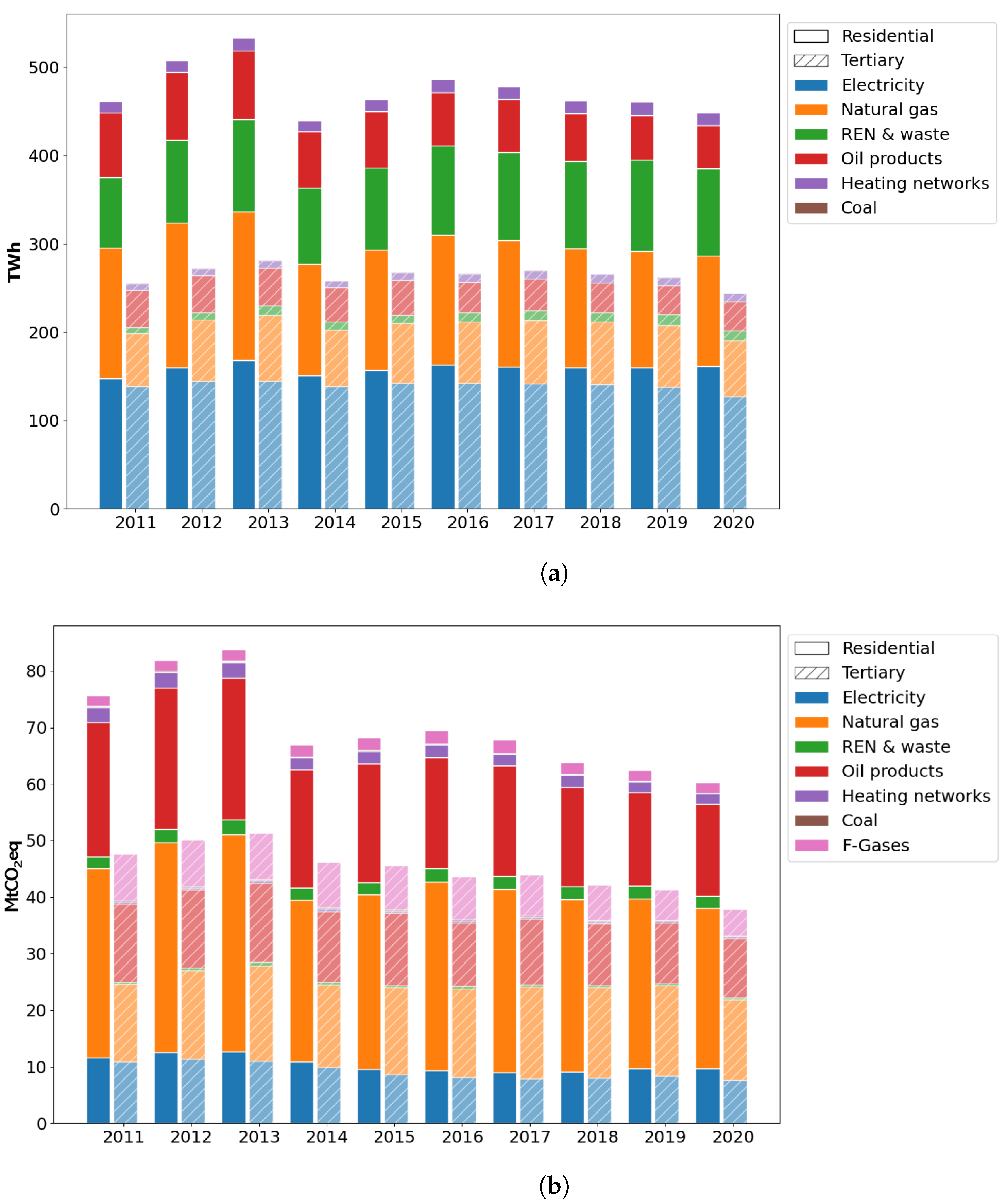

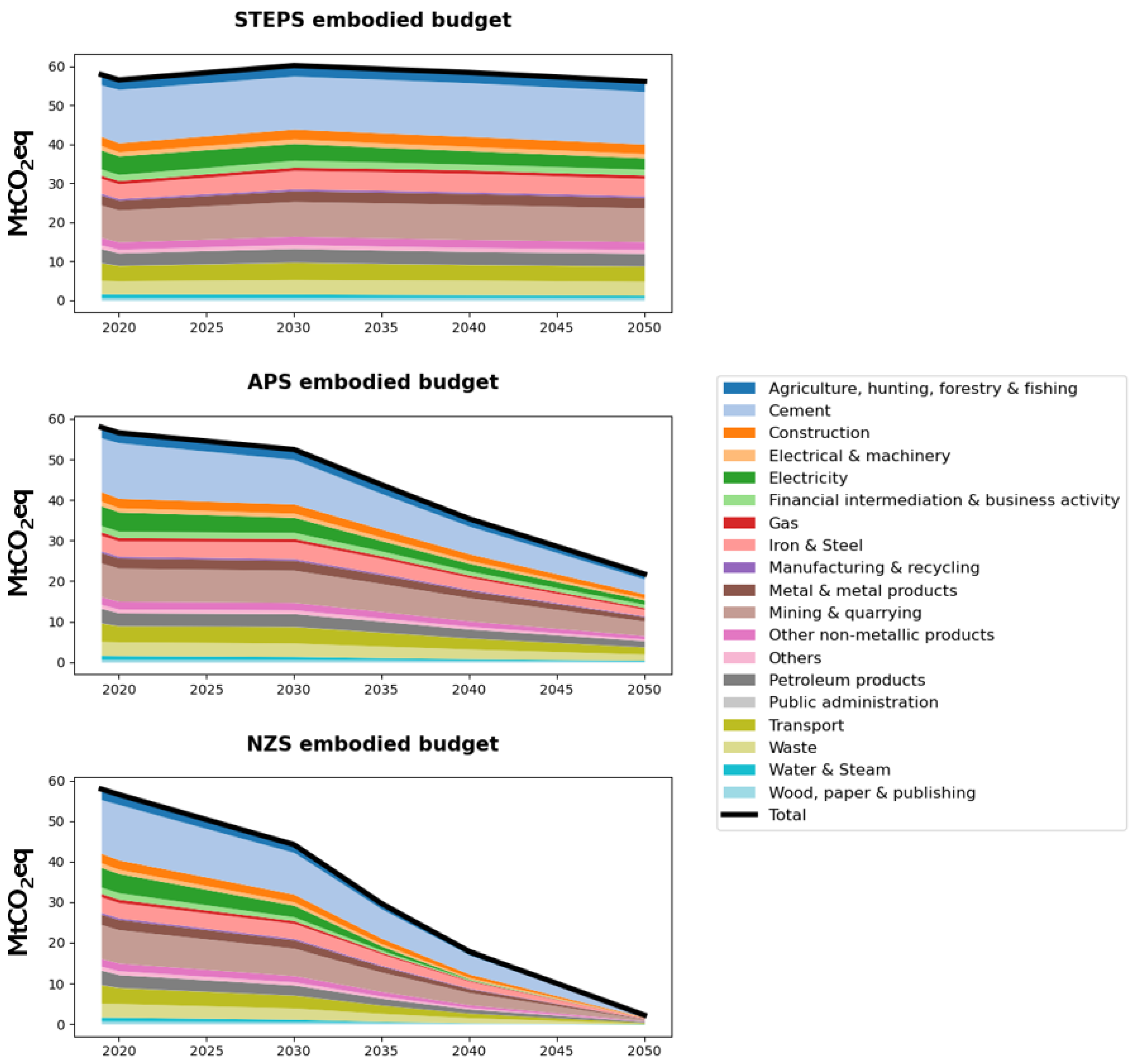

| Direct Operational GHGEs | Indirect Operational GHGEs | Embodied GHGEs | |
|---|---|---|---|
| GHG Protocol | Scope 1 | Scope 2 | Scope 3 |
| EN-15978 | B6–B7 | A1–A5 B1–B5 C1–C4 | |
| IPCC | Residential (1.A.4.b), Commercial /institutional (1.A.4.a) | Public electricity, heat production (1.A.1.a) | All others |
| SECTEN | Residential Tertiary | Energy | Industry Transport Waste LULUCF Agriculture |
| D-EF | LC-EF | |
|---|---|---|
| Biomass | 0 | 0.0288 |
| Geothermal | 0 | 0.045 |
| Solar thermal | 0 | 0.055 |
| Biogas | 0.0428 | 0.044 |
| Electricity (average) | 0.0418 | 0.0607 |
| Heat | 0.107 | 0.132 |
| Natural gas | 0.204 | 0.227 |
| LPG | 0.233 | 0.272 |
| Oil products | 0.272 | 0.325 |
| Coal | 0.345 | 0.377 |
| Scenario Category | Scenario Type | |
|---|---|---|
| Net-Zero 2050 (NZS) | Normative | Transforming |
| Announced Pledges Scenario (APS) | Predictive | What-if |
| Stated Policies Scenario (STEPS) | Predictive | Forecasts |
| Region | Sector | MtCO2eq | % |
|---|---|---|---|
| France | Cement, lime, and plaster | 9.14 | 15.8% |
| France | Construction work | 2.14 | 3.7% |
| France | Stone | 1.74 | 3% |
| France | Supporting and auxiliary transport services | 1.14 | 2% |
| France | Waste for treatment: Landfill | 1 | 1.7% |
| RoW Africa | Cement, lime, and plaster | 0.9 | 1.6% |
| China | Basic iron and steel | 0.79 | 1.4% |
| China | Electricity by coal | 0.77 | 1.3% |
| France | Basic iron and Steel | 0.75 | 1.3% |
| France | Transportation services | 0.64 | 1.1% |
Disclaimer/Publisher’s Note: The statements, opinions and data contained in all publications are solely those of the individual author(s) and contributor(s) and not of MDPI and/or the editor(s). MDPI and/or the editor(s) disclaim responsibility for any injury to people or property resulting from any ideas, methods, instructions or products referred to in the content. |
© 2024 by the authors. Licensee MDPI, Basel, Switzerland. This article is an open access article distributed under the terms and conditions of the Creative Commons Attribution (CC BY) license (https://creativecommons.org/licenses/by/4.0/).
Share and Cite
Pellan, M.; Almeida, D.; Louërat, M.; Habert, G. Integrating Consumption-Based Metrics into Sectoral Carbon Budgets to Enhance Sustainability Monitoring of Building Activities. Sustainability 2024, 16, 6762. https://doi.org/10.3390/su16166762
Pellan M, Almeida D, Louërat M, Habert G. Integrating Consumption-Based Metrics into Sectoral Carbon Budgets to Enhance Sustainability Monitoring of Building Activities. Sustainability. 2024; 16(16):6762. https://doi.org/10.3390/su16166762
Chicago/Turabian StylePellan, Marin, Denise Almeida, Mathilde Louërat, and Guillaume Habert. 2024. "Integrating Consumption-Based Metrics into Sectoral Carbon Budgets to Enhance Sustainability Monitoring of Building Activities" Sustainability 16, no. 16: 6762. https://doi.org/10.3390/su16166762
APA StylePellan, M., Almeida, D., Louërat, M., & Habert, G. (2024). Integrating Consumption-Based Metrics into Sectoral Carbon Budgets to Enhance Sustainability Monitoring of Building Activities. Sustainability, 16(16), 6762. https://doi.org/10.3390/su16166762









